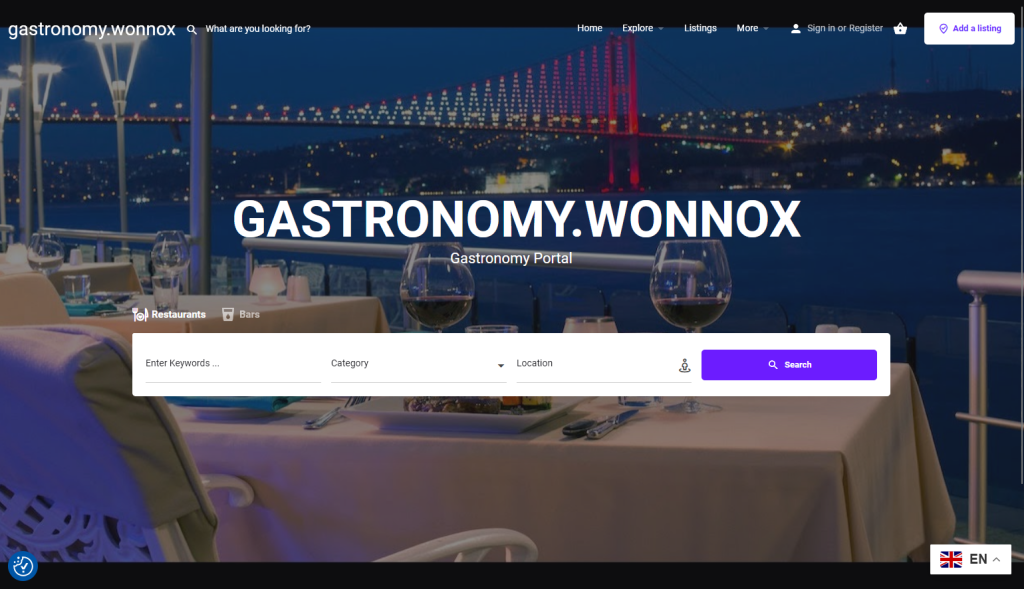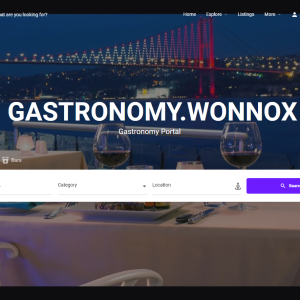
- Direct message
- Leave a review
- Bookmark
- Share
- Report
- prev
- next
Description
A comprehensive and appealing bar listing in a web directory under the category of gastronomy is crucial for attracting new patrons and retaining existing ones. It should convey the bar's unique atmosphere, offerings, and special features while providing all the necessary details for customers to make informed decisions. Here’s an in-depth guide to crafting a standout bar profile, including essential information and additional features to make it shine:
1. Bar Overview
Name: The bar's name should be prominently displayed at the top of the profile. A memorable and catchy name helps make a strong first impression.
Logo: A high-resolution logo adds to brand recognition and should reflect the bar’s character, whether it’s a trendy cocktail bar or a cozy pub.
Tagline: A short, catchy tagline can sum up the bar’s vibe or specialty (e.g., “Craft Cocktails with a Local Twist” or “The Best Speakeasy in Downtown”).
2. Location and Contact Information
Address: A complete address, ideally with a pin on an interactive map like Google Maps, helps customers easily locate the bar.
Phone Number: A click-to-call feature makes it convenient for mobile users to call the bar for reservations or inquiries.
Email Address: An email for reservations, event inquiries, or general questions.
Website Link: A link to the bar's official website where users can explore further information.
Operating Hours: Detailed hours for each day, including information about last call, if applicable, or special holiday hours.
3. Visual Content
Photos of the Bar: High-quality images are essential for showcasing:Interior décor and ambiance.
Seating areas (indoor, outdoor, bar seating).
The bar counter and shelving to display the range of spirits.
Images of any unique features, like pool tables, patios, or cozy nooks.
Drink and Food Photos: Professional photos of signature cocktails, beers, wines, and any food offerings can be a great draw. These visuals should highlight the most visually appealing items.
360-Degree Virtual Tour: A virtual tour allows potential customers to explore the bar’s layout and atmosphere, giving them a sense of the space before visiting.
4. Menu Details
Drink Menu: A downloadable or interactive menu with categories like cocktails, beer, wine, and spirits. Including prices can help manage customer expectations.
Signature Cocktails: Highlighting a few of the bar’s specialty drinks with descriptions can attract cocktail enthusiasts.
Happy Hour Menu: Details about happy hour times, including drink specials and discounted appetizers.
Food Offerings: If the bar serves food, a section dedicated to small plates, bar snacks, or a full dining menu is important.
Dietary Options: Information about vegetarian, vegan, gluten-free, or allergen-free options is valuable for customers with specific dietary needs.
5. Special Offers and Events
Happy Hours and Special Deals: Clearly display happy hour times, weekly specials, or discounts on particular drinks or appetizers.
Live Music and Events: Information about live music nights, DJ sets, trivia nights, karaoke, or any special events.
Event Calendar: A simple calendar showing upcoming events, from themed parties to local band performances.
Private Events: Details about hosting private events like birthday parties or corporate gatherings. Include room rental options, available packages, and contact information for booking.
6. Online Reservations and Ordering
Online Booking System: Integration with reservation platforms (like OpenTable) or a custom booking form makes it easier for customers to reserve tables or book for special events.
Order for Pickup or Delivery: If the bar offers cocktails to-go or food delivery, include links to relevant delivery services (e.g., DoorDash, Uber Eats).
Virtual Events: If the bar hosts online cocktail-making classes or virtual happy hours, include sign-up links and schedules.
7. Customer Reviews and Ratings
Customer Testimonials: Featuring positive reviews can build trust and credibility. Highlight reviews that praise the bar’s atmosphere, service, and drink quality.
Star Ratings: Display an average rating from Google, TripAdvisor, or Yelp to give a snapshot of customer satisfaction.
Reply to Reviews: A section where bar management can respond to customer feedback shows engagement and dedication to customer service.
8. About the Bar
History and Background: A brief history of the bar, its founding, and any unique aspects of its story, such as historical significance or a notable founder.
Bartender Profiles: Highlighting the head bartender or mixologist can add personality to the listing and emphasize the quality of the drinks.
Mission Statement: A short statement about the bar’s philosophy, commitment to using local ingredients, or focus on creating a particular atmosphere.
9. Ambiance and Atmosphere
Description of Ambiance: A few sentences that capture the bar’s vibe—whether it’s a chic lounge, a dive bar, or a relaxed pub.
Music Style: Information on the type of music played (e.g., jazz, rock, electronic) can help potential customers find a bar that matches their taste.
Lighting and Decor: Describe features like dim lighting for a cozy feel, neon signs for a trendy look, or vintage decor for a nostalgic atmosphere.
10. Accessibility and Facilities
Parking Information: Details about nearby parking, valet services, or any recommendations for where patrons can park.
Accessibility Features: Information about wheelchair access, ramps, and accessible restrooms ensures inclusivity.
Outdoor Seating: If available, describe the patio or outdoor seating area, including any seasonal features like heaters or fire pits.
11. Social Media Integration
Social Media Links: Include links to the bar’s social media profiles (e.g., Instagram, Facebook, TikTok) where users can see updates, photos, and events.
Instagram Feed: An embedded Instagram feed showing recent posts, which could include new cocktails, event highlights, or behind-the-scenes shots.
Social Media Share Buttons: Encourage visitors to share the listing on their own social media, boosting the bar’s visibility.
12. Certifications and Awards
Awards and Recognitions: Display awards, like “Best Cocktails” or local accolades, to highlight the bar’s reputation.
Sustainability Practices: Information on eco-friendly practices, such as recycling programs or partnerships with local suppliers, can appeal to environmentally conscious patrons.
13. Payment Options
Accepted Payment Methods: List all accepted payment methods, including major credit cards, contactless payments, and digital wallets like Apple Pay.
Gift Card Availability: Details on purchasing gift cards for the bar, which can be a popular option for gifts.
14. Loyalty Programs and Memberships
Rewards Programs: Information on any loyalty programs that offer perks like free drinks, discounts, or exclusive access to events.
Membership Clubs: For bars offering special memberships (e.g., whiskey clubs or wine societies), provide details on benefits and how to join.
15. Community Engagement
Local Partnerships: Highlight any partnerships with local breweries, wineries, or distilleries, emphasizing the bar's support for local businesses.
Charity Events and Fundraisers: Showcase any involvement in charity events or local fundraisers, which can help build a positive image in the community.
16. SEO Optimization
Keyword Optimization: Use relevant keywords like “best craft beer bar,” “cocktail lounge,” or “live music bar” to improve search visibility.
Meta Description: A concise meta description that appears in search results, encouraging clicks by summarizing the bar’s unique offerings.
Location-Based Keywords: Include keywords specific to the bar's neighborhood or city to attract local patrons.
Conclusion
A well-crafted bar listing in a web directory should blend essential information with appealing visuals and engaging descriptions. It should communicate the bar's unique atmosphere and offerings while making it easy for customers to access key details like location, menu, and special events. By integrating features like social media, online booking, and customer reviews, the profile becomes a powerful tool for attracting new patrons and keeping loyal customers informed about what’s happening at their favorite spot. In a competitive industry like gastronomy, a detailed and polished listing can make all the difference in drawing in a crowd.

Add a review